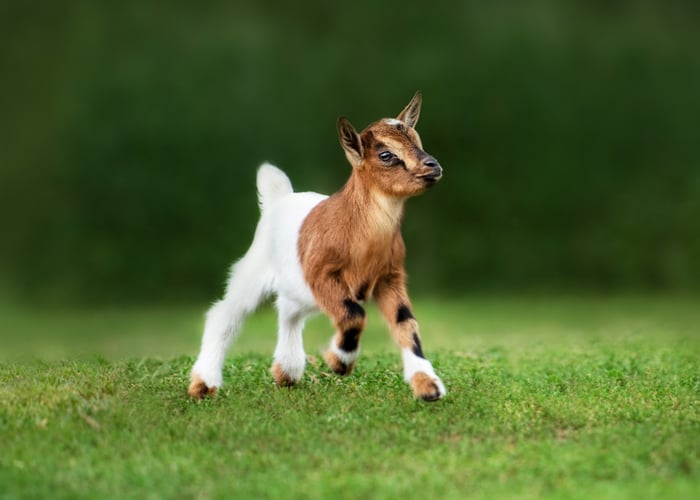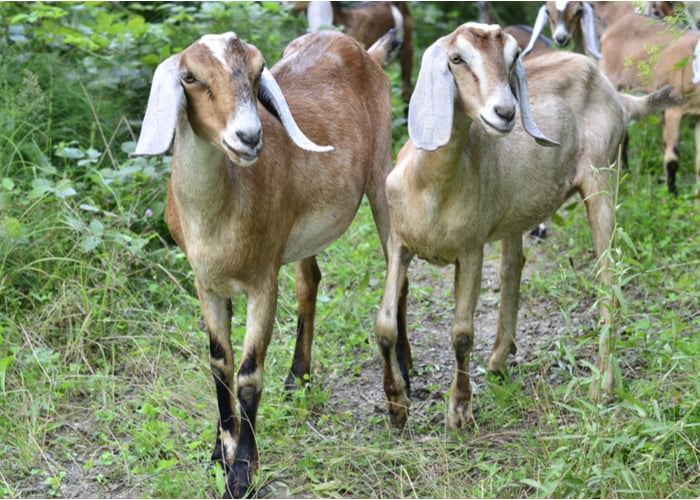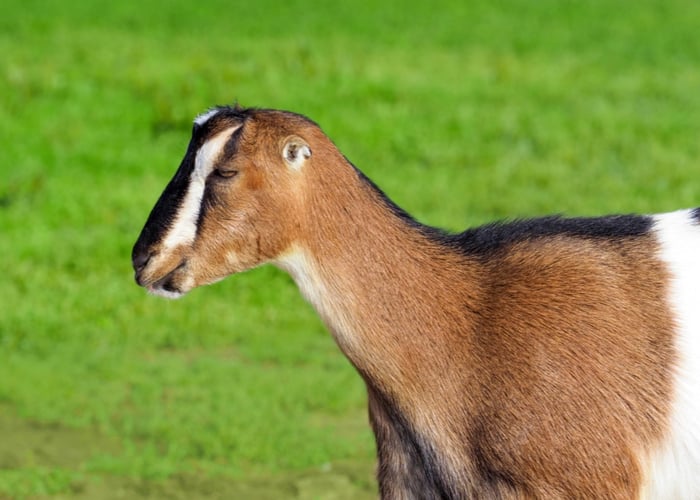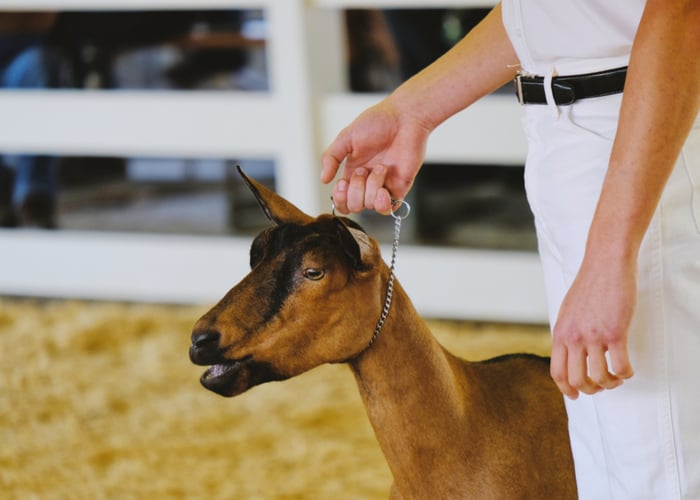Are you looking to add the perfect pet goat to your family?
Whether you’re a farmer, homesteader, or just someone who loves animals, these hornless goat breeds are some of the best additions to any home.
Not only do they provide an all-natural source of fresh milk, meat, or fiber, but their friendly and playful personalities will quickly make them part of the family.
Read on to learn more about different types of hornless goats and why they could be the right choice for you!
Hornless Goat Breeds: What Are Polled Goats?
Goats have been around for centuries. For much of that time, the majority of goats had horns.
Horns serve many purposes, from helping to protect the goat from predators to providing them with access to food that may have otherwise been inaccessible.
However, horns can be dangerous for other animals in the herd and can even be hazardous when it comes to milking or keeping goats in pens or stalls. This is where polled goats come in!
Polled goats are animals that have naturally smooth heads with no horns whatsoever. It is believed that this trait first appeared in Switzerland during the 17th century and has since spread around the world.
Polled goats can come in any breed or color and can even be found among wild herds of mountain goats.
The largest benefit of having polled goats instead of horned ones is their safety.
They cannot hurt each other or any humans who may need to handle them while they are being milked or shorn.

Why Do Goats Have Horns in the First Place?
Like many other animals, goats evolved horns as a part of their natural defense mechanisms.
When threatened by predators, goat horns can be used to protect them from harm and even to fight back if necessary.
In addition to predators, horns also help goats compete with other members of their herd for food and mates. Unlike other animals, such as deer, which shed their antlers annually, goats keep their horns year-round.
This is because the horn is an essential part of a goat’s anatomy. Without it, they would be unable to defend themselves or compete for resources effectively.
As goats age, their horns continue to grow throughout life and can reach up to two feet in length!
The growth pattern of goat horns varies greatly depending on the breed—some breeds have short curved horns while others have longer spiraled ones.
Interestingly enough, scientists have found that horn size is actually determined by genetics rather than nutrition or environment.
This means that a goat’s horn size will remain relatively consistent throughout its lifetime regardless of its diet or living conditions.
In addition to being functional body parts obtained through natural selection, goat horns are also seen as symbols of power and strength in many cultures around the world.
From ancient Greek mythology (where Zeus famously turned himself into a billy goat) to modern-day folklore (the mythical “cornucopia” filled with abundance), goat horns have been widely associated with good fortune and abundance—a fitting tribute for these hardy animals!
Benefits of Raising Polled Goats
At first glance, polled goats don’t seem all that different from other breeds—but looks can be deceiving!
For one thing, these goats are much easier to handle than their horned counterparts since they don’t have any horns to get in the way.
This makes it simpler to herd them and keep them in line, which is great news for farmers who want to control their livestock without spending too much time doing so.
Like all other goats, polled goats are known for being hardy animals. They can be raised nearly anywhere with relative ease (though you’ll still need to provide plenty of food and water!).
Finally, polled goats are known for being quite friendly—not only towards humans but also with other animals on the farm.
Without horns, they’re less likely to be aggressive toward your other livestock or pets. These gentle giants make great companions for other farm animals and will often form close bonds with their fellow critters over time.
This makes them an ideal choice for farmers looking for a sociable animal that won’t cause too much trouble in the barnyard!
7 Best Hornless Goat Breeds
Technically, all goats have horns. However, there are, in fact, some breeds of goats that do not typically grow horns.
These breeds of “hornless” goats include the Pygmy Goat and Nigerian Dwarf Goat. So while these “hornless” goats are often born without horns, it is also very possible that they can have horns. There’s no guarantee!
That said, if you’re looking for goats that are more likely to not have horns, here are some goat breeds to consider.

Nigerian Dwarf
The Nigerian Dwarf goat is a special breed of dairy goat renowned for its small size and even temperament.
What stands out most about this breed of goats is that they are more likely to be polled, meaning they do not possess horns or have them removed.
Consequently, their risk of injury—and potential for injuring others—is much lower than other breeds, making them an excellent choice when working with children or in a petting zoo setting.
In addition to their safe demeanor, these goats produce a surprisingly high volume of milk for their frame size and provide delicious dairy products.
This herd animal is basically low-maintenance yet still provides immense value—making it a popular choice among many livestock keepers.

Nubian Goat
The Nubian Goat is a friendly, hardy breed that is renowned for its distinct physical features and high production of delicious milk.
This goat boasts long pendulous ears, an arched nose, and a more prominent Jacobin forehead caused by the genetic trait of being born without horns.
Not only are they dairy goats, but their meat is also sought out by farmers who value its sweet flavor.
The versatility of the Nubian is unmatched. Their colorful personalities have proven to make them excellent pets for small hobby farms while at the same time providing substantially for family economics when used on larger commercial farms.

LaMancha
LaMancha is a popular breed of goat, especially prized for its small size, excellent production of milk, and unique large ears.
The breed is known for being polled, meaning the goats have no horns, making them seem docile and friendly.
LaManchas are incredibly efficient producers of milk and can make great companions due to their inquisitive nature.
They’re an ideal choice for small farms or hobby farmers due to their manageable size, even when fully grown.
LaManchas are often used as dairy goats because they produce an abundance of creamy high-butterfat milk.
This makes them perfect for cheese making, soap creation, and other artisanal products that call for a rich cream or butterfat content in their ingredients.
Maltese
Maltese goats are a unique breed due to their greater likelihood of being polled, meaning they do not have horns.
These cute critters tend to be on the small side and quite docile, making them easier to manage than other breeds.
They are primarily kept as dairy goats, raised for both their milk and meat production. This loving nature, combined with their hardy dispositions, make for a great family pet too!

Alpine Goats
Alpine goats are a type of dairy goat that is known for having a friendly, gentle disposition and for producing copious amounts of milk.
They originated in the Alps region of Europe but today can be found on farms around the globe.
The breed is well-adapted to cool climates and can generally survive well on rougher terrain compared to other breeds of goats.
Alpine Goats usually produce two or more gallons of milk per day, and their milk is high in both protein and butterfat content, making it ideal for cheese-making.
These goats are mainly raised for their milk production, but they can also be used as show animals and even pets due to their congenial nature.
An added bonus with this breed is that they tend to be polled—meaning that they’re born without horns—which is why families raising them don’t have to worry about disbudding the kids.

Miniature Oberhasli
The Miniature Oberhasli is a miniature breed of goat originating from Switzerland and Germany. It was created by breeding a Nigerian Dwarf and Oberhasli goat.
Today, this is a popular dairy goat known for its friendly, gentle temperament and impressive maternal instincts.
The Miniature Oberhasli usually grows to be between 28 and 32 inches in height, and they weigh an average of 80-120 pounds.
This breed tends not to grow horns, making them easier to handle (especially for smaller households).
Because of their distinct creamy-brown coloring, along with their charismatic personalities, these goats are often chosen as pets and family members in many homes.
However, the Miniature Oberhasli also succeeds as a dairy goat—producing large amounts of milk that’s high in protein and cream content.
So whether you’re looking for a friendly pet or high-quality dairy products, the Miniature Oberhasli should be at the top of your list!
Toggenburg
The Toggenburg goat is a unique breed that originates from the mountainous region of Switzerland. Known as a ‘pigmy’ breed, they are smaller than standard goats and typically possess a brown-gray coloration.
This breed is also distinct in that it is much more likely to be polled or free of horns—a trait that makes it especially popular with farmers and homesteaders who have younger children.
Other features that make Toggenburg goats high in demand for farm animal use include their moderate success at producing milk and their ease of adapting to different climates.
Plus, its meat is known to be exceptionally flavorful and tender compared to other breeds’ making them highly sought after by butchers and gourmands alike.
All in all, while they might not be the most profitable goat breed available, their affordability, paired with the low amount of maintenance needed, has made them an incredibly popular choice amongst those looking for a new farmyard addition.

Should I Disbud My Goats?
If you’ve ever seen a goat, you know that its horns can be quite impressive. But what if you don’t want a goat with horns?
That’s where disbudding comes in!
Disbudding is the process of removing the horn buds from a young goat before they grow into full-sized horns. This can be done for various reasons, and it isn’t always an easy decision to make.
The main benefit of disbudding goats is that it eliminates any risks associated with having horns on your farm. Horned goats can cause damage to themselves or other animals, as well as any property they come into contact with.
If you have children or other animals on your farm, this might be an important factor in deciding whether or not to disbud your goats.
Additionally, some people believe that disbudded goats are less likely to get stuck in fences or choke on hay bales due to their lack of horns.
On the other hand, there are also some drawbacks to disbudding goats. Depending on how it is performed, disbudding can be painful for the animal and cause long-term issues such as infection or scarring.
Also, some argue that because horned goats have evolved with them for so long, taking away their horns essentially removes part of their natural defense system against predators.
It is important to consider these points carefully before deciding whether or not to disbud your goats.
FAQ About Hornless Goat Breeds
Do female goats have horns?
Most breeds of goats are naturally horned animals, meaning both male and female goats can have horns.
However, there are certain breeds in which the females are naturally polled (without horns).
This is especially true in dairy goat breeds, as many breeders remove the horns from their female goats for safety reasons.
Can any goat breed have horns?
Yes—but not always! While most goat breeds come with the potential to be horned or polled (without horns), there are certain breeds that only come hornless.
For example, Nigerian Dwarf and Pygmy goats are naturally polled—so even though they technically could have horns, they rarely do.
In addition, some breeders will disbud (remove) the horns from almost any type of goat regardless of its natural propensity for having them or not.
Hornless Goat Breeds: Final Thoughts
Polled goats are becoming increasingly popular with farmers and pet owners alike due to their natural lack of horns and increased safety over traditional horned breeds.
While horns may still serve some purpose for wild goats in terms of protection from predators, the benefits of having polled animals far outweigh any potential drawbacks when it comes to domestic agriculture or pet ownership.
Consider some of the goat breeds above that are more likely to be polled—trust us, you’ll thank us later!
